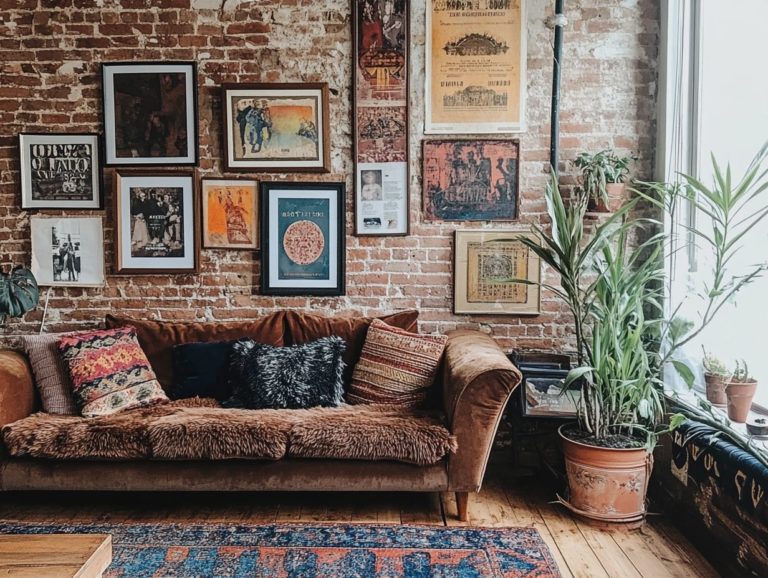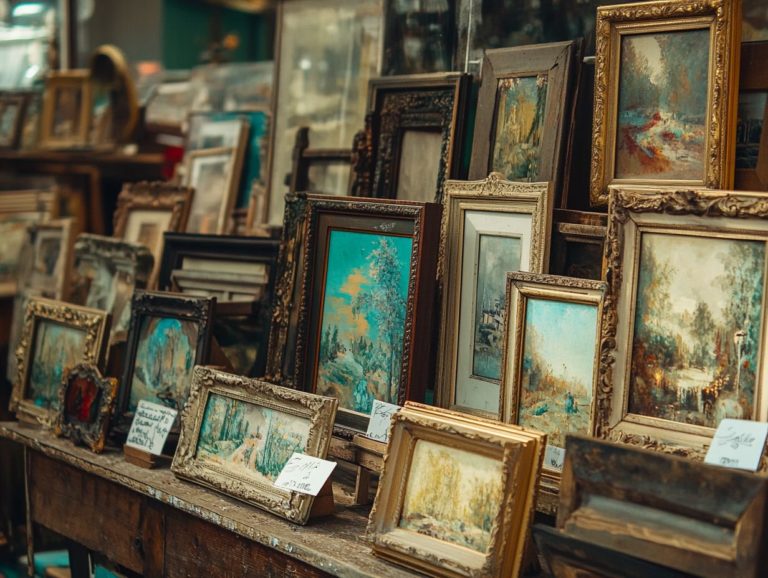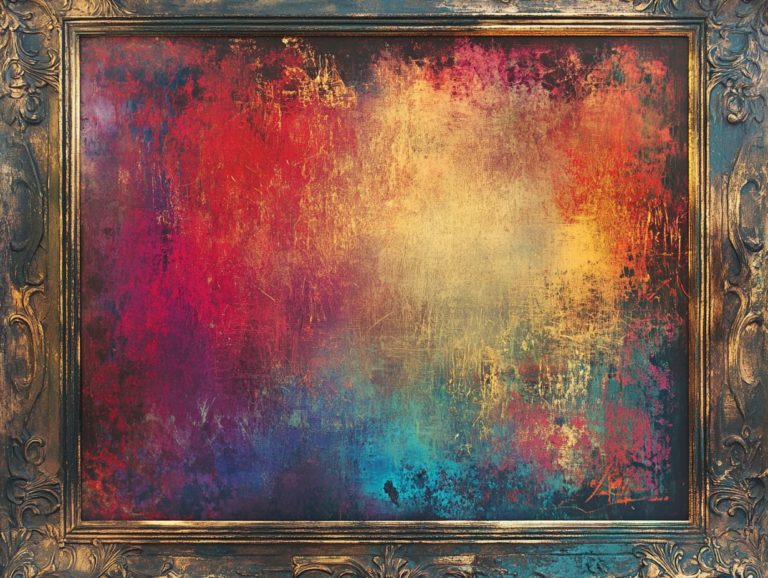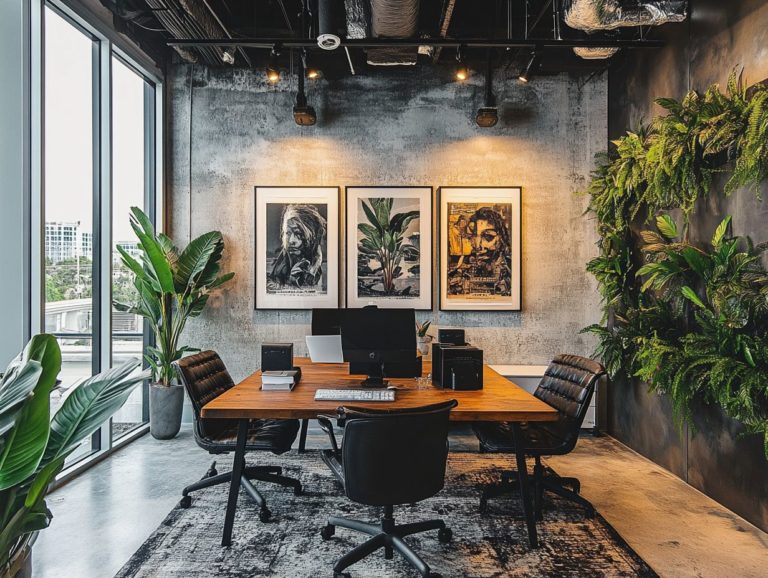How to Create a Vintage Wall Art Mood Board
Creating a vintage wall art mood board allows you to tap into your creativity while infusing nostalgic aesthetics into your space.
This guide explores the essence of mood boards and the charm that vintage themes bring. You’ll also gain insights on how to gather your inspiration effectively.
Discover practical steps for curating your mood board, from selecting the perfect visuals to crafting your final design. Get ready to unleash your creativity!
Contents
- Key Takeaways:
- Gathering Inspiration for Your Mood Board
- Creating Your Vintage Wall Art Mood Board
- Using Your Mood Board for Design Projects
- Frequently Asked Questions
- How do I gather inspiration for my vintage wall art mood board?
- What materials do I need for my vintage wall art mood board?
- How do I arrange the elements in my vintage wall art mood board?
- Can I include personal items in my vintage wall art mood board?
- What should I do with my vintage wall art mood board once it’s completed?
Key Takeaways:
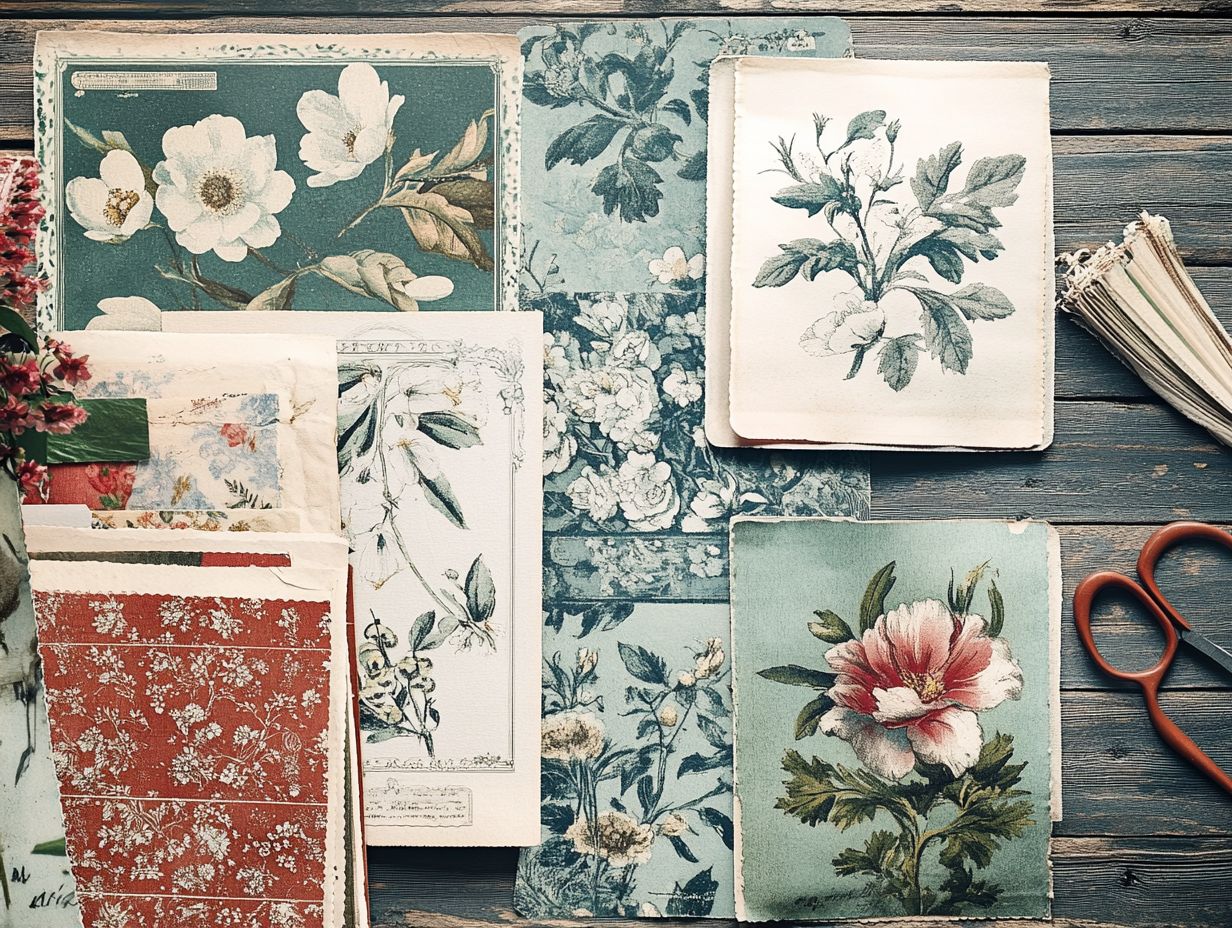
- Mood boards are visual collages that inspire design projects.
- A vintage theme adds nostalgia, creating a unique look.
- Gather inspirations from various vintage styles to bring your theme to life.
What is a Mood Board?
A mood board is your visual compass, curated to convey your design inspiration and aesthetics. It brings together elements color groups, textures, and design layouts to establish a cohesive look. Think of it as your creative playground to organize your thoughts before diving into the design work. For anyone passionate about home decor or interior design, it s an essential tool.
Using a mood board allows you to explore the intricacies of color balance. This ensures that tones harmonize beautifully and evoke the desired emotional response. It helps you identify the right design elements to carry your vision across different spaces.
For example, when preparing for a living room transformation, a mood board helps you visualize how furniture pieces, artwork, and textiles come together. Additionally, knowing how to use vintage wall art in contemporary spaces can enhance your design. This approach enables informed choices and streamlines your decision-making, leading to a polished and intentional design outcome.
Why Use a Vintage Theme?
Choosing a vintage theme brings charm and character to your home. It creates a unique space that showcases your style and creativity. Vintage frames and artwork cultivate a cozy ambiance and allow for eclectic arrangements of various textures and colors, forming an inviting visual tapestry.
Incorporating items from different eras evokes a sense of nostalgia, reminding you of cherished memories. This thoughtful curation creates a warm atmosphere, inviting guests to linger and discover the stories behind each piece.
Whether it s a retro lamp or a collection of antique trinkets, these decorative elements harmonize effortlessly to establish design coherence in your home. By mixing vintage finds with modern pieces, you can customize your space to reflect your aesthetic preferences, crafting a captivating look that stands the test of time.
Gathering Inspiration for Your Mood Board
Gathering inspiration for your mood board is an essential step in your creative journey. This process allows you to compile diverse elements that resonate with your unique aesthetic and project objectives.
Whether you re unearthing vintage treasures at thrift stores or browsing platforms like Etsy and Mpix for distinctive prints, this phase enables you to curate a compelling design tool that guides your project through every stage.
Exploring Vintage Aesthetics
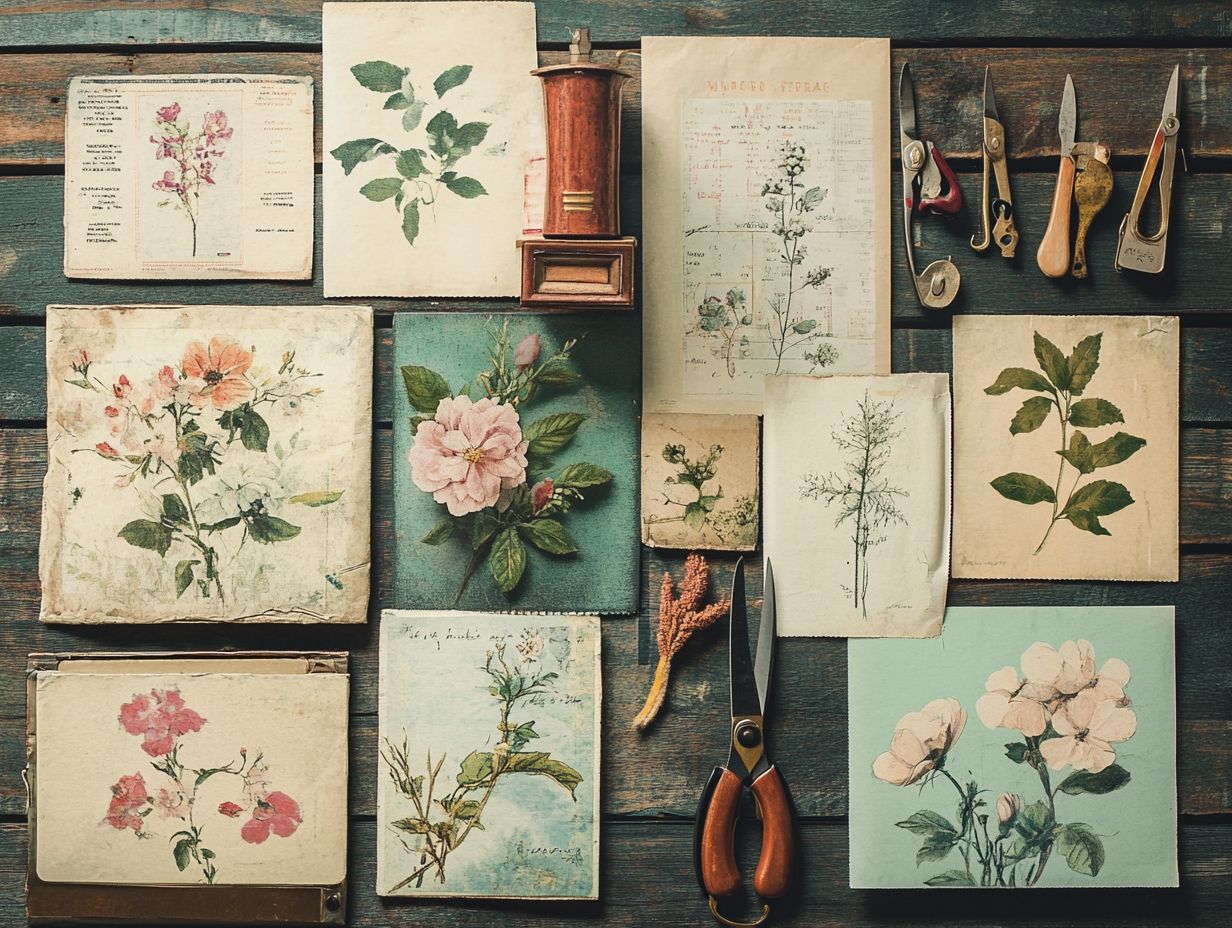
Exploring vintage aesthetics invites you to immerse yourself in a rich tapestry of styles. These decorative items resonate with history and evoke nostalgia.
Picture rustic finishes and floral accents blending to create an inviting ambiance. This journey elevates your mood board and guides your decisions on artwork display and overall design layout.
From the sleek lines of mid-century modern to the ornate details of Victorian elegance, vintage styles offer many options for crafting an inviting atmosphere. Consider integrating a worn leather armchair alongside an antique wooden coffee table.
Layering textiles, like a vintage quilt draped over a contemporary couch, infuses character and warmth into your space. Mixing and matching various textures, colors, and patterns enriches your environment while ensuring design coherence that honors the charm of bygone eras.
By thoughtfully curating these elements, you can transform your living area into a personal time capsule, brimming with stories and artistry waiting to be discovered.
Collecting Visuals and Textures
Collecting visuals and textures is essential in crafting your mood board. It allows you to assemble a variety of elements that truly reflect your desired aesthetic and thematic direction.
From vintage frames to unique prints on sketch paper, these items contribute to a rich tapestry of inspiration that can guide your home decor or artwork display.
To effectively source these elements, consider looking into local thrift shops, antique stores, and even online marketplaces like Shutterfly or Vistaprint where you might uncover forgotten treasures. Exploring these places can reveal textures like distressed wood, faded fabrics, or aged paper, enabling you to make thoughtful choices that fit perfectly with your vintage theme.
As you curate your visuals, ensure they harmonize in color and style, weaving a cohesive narrative. Integrating these elements into your mood board should evoke a sense of nostalgia and elegance, ensuring that each piece enhances the overall artistic arrangement. For tips on achieving this look affordably, check out how to decorate with vintage wall art on a budget. A well-organized collage of visuals can serve as your guiding star, steering your design journey in a unified direction.
Creating Your Vintage Wall Art Mood Board
Creating your vintage wall art mood board is an exhilarating endeavor. It weaves together all the inspiration and elements you’ve collected, allowing you to envision how they will harmonize in your space.
By exploring different framing options different ways to display your artwork and design layouts, you can craft a cohesive aesthetic that enhances your home accessories and beautifully showcases your unique style and preferences.
Tools and Materials Needed
To successfully create your vintage wall art mood board, gather a variety of tools and materials that streamline the process. Think sawtooth hangers for effortless display, an array of framing options, and decorative items that elevate the visual appeal. Having these essentials at your fingertips will ensure a smoother creative journey and help you achieve your design goals.
Beyond the basics, consider incorporating items like washi tape and adhesive putty. They offer the flexibility to rearrange your artwork without risking damage to your walls. Additionally, vintage-inspired fabrics or wallpaper samples can serve as captivating backdrops, enhancing the overall aesthetic. For a unique touch, learn how to mix vintage wall art with modern decor.
A corkboard or magnetic board is invaluable for organizing your ideas and visual references, making it easy to update as inspiration strikes. Plus, collecting nostalgic trinkets or old postcards adds a personal charm that ties your entire mood board together, ensuring it captures the unique narrative that inspires your artwork on display. For a creative twist, learn how to use vintage wall art in eclectic decor to enhance your collection.
Step-by-Step Guide
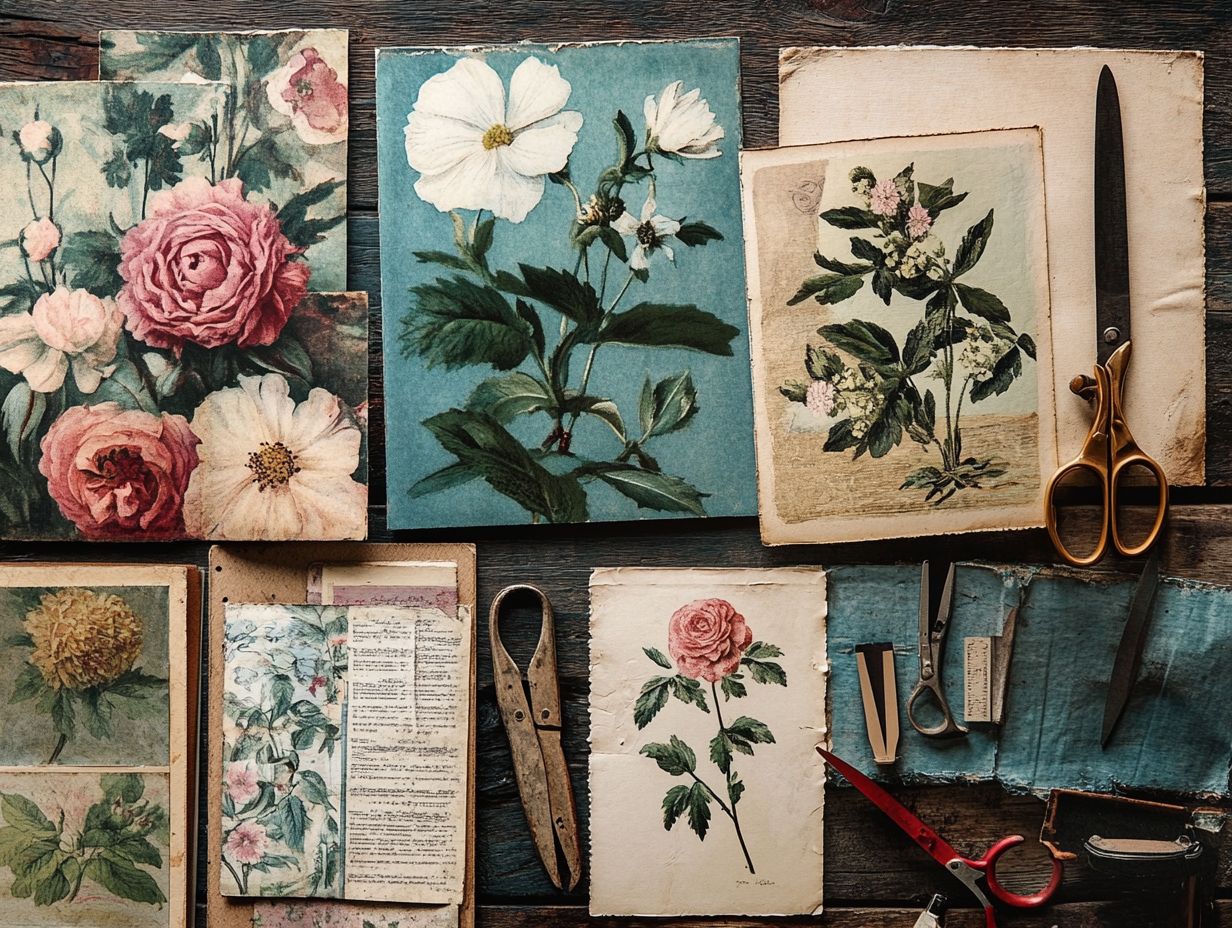
This step-by-step guide will help you craft a vintage wall art mood board that captures the aesthetic you desire. It will aid in measuring your space and planning your design layout. By thoughtfully selecting and combining vintage items, you can create a harmonious arrangement that truly reflects your personal style.
-
Start by measuring the designated wall space accurately. Take careful notes of both height and width. This ensures that your layout complements the proportions of your room and avoids a cluttered appearance.
-
Next, gather images, frames, and accessories that embody your chosen theme. Pay close attention to colors, textures, and dimensions.
-
Once you have your elements in hand, lay them out on a flat surface. Explore various arrangements while keeping balance and visual flow in mind.
-
After you’ve settled on a design that speaks to you, transfer your layout to the wall. Secure each piece with intention to create a polished and inviting display.
Using Your Mood Board for Design Projects
Using your mood board for design projects serves as a refined reference point and visual guide throughout your creative journey. It ensures that every element resonates with your original vision.
Incorporate insights and strategies drawn from your mood board. Choose framing options and preserve design coherence to effortlessly bring your ideas to life with greater effectiveness.
Tips for Incorporating Your Mood Board into Design Work
Incorporating your mood board into your design work requires a thoughtful approach. Ensure that your final project embodies the desired color palette and character traits that sparked your inspiration. With the right strategies, you can translate the vision from your mood board onto the canvas of your space.
Start by distilling the core themes you’ve identified. Allow those essential elements to guide your decisions regarding textures, furniture, and accessories. As you select items, consistently refer back to your board to maintain design coherence. For inspiration on wall decor, consider how to create a vintage-style gallery wall. This practice will ground your work in the aesthetic you envisioned.
Consider crafting a checklist inspired by your mood board. Evaluate how each component contributes to the overall narrative. This will enhance the creative process and ensure your design serves as a cohesive representation of the emotions and ideas your mood board encapsulates. Additionally, you can explore how to style vintage wall art with modern pieces to elevate your interior design further.
Examples of Vintage Wall Art Inspired by Mood Boards and Gallery Walls
Explore examples of vintage wall art inspired by mood boards to gain valuable insights. See how various elements come together to create stunning displays. From curated collections of unique prints to thoughtful arrangements of vintage frames, these examples demonstrate the potential of effectively using a mood board in your home decor.
Select pieces that reflect a cohesive theme whether it be florals, landscapes, or abstract designs. This showcases your personal taste and enhances the ambiance of your space. Techniques like layering different textures and colors add depth, while placing larger pieces at eye level ensures that your collection flows harmoniously. For inspiration, check out this guide on how to create a vintage-inspired gallery wall.
Incorporate design elements such as contrast and symmetry to elevate visual appeal and create an inviting atmosphere. A well-curated mood board serves as your guiding blueprint, ensuring that every art piece contributes to a harmonious overall aesthetic. For inspiration, consider revamping your space with vintage wall art ideas. This ultimately transforms your walls into expressive canvases.
Frequently Asked Questions
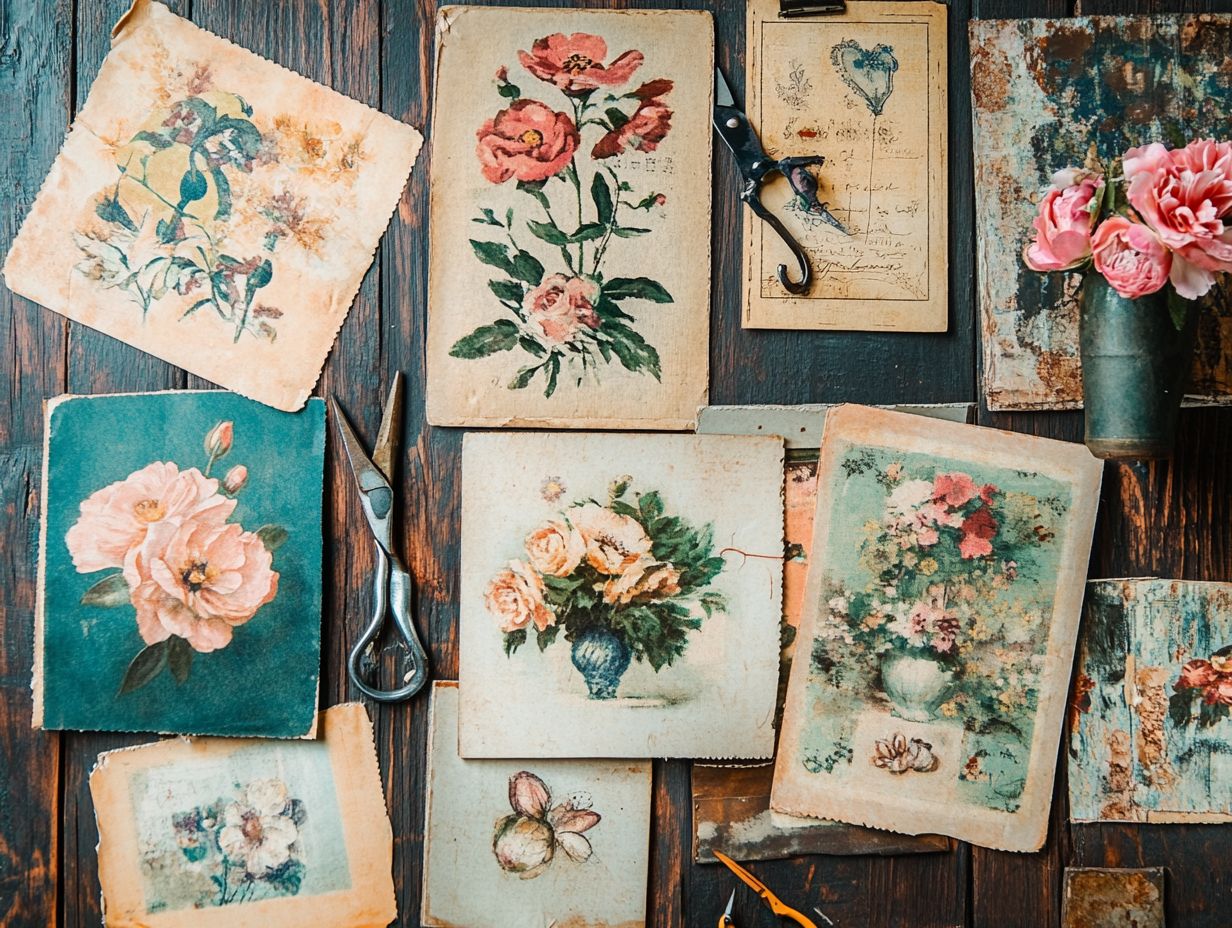
What is a vintage wall art mood board?
A vintage wall art mood board is a visual representation of your ideas and inspiration for creating a vintage-themed wall art for your space. It typically includes images, colors, textures, and other elements that help you visualize your design.
How do I gather inspiration for my vintage wall art mood board?
Gather inspiration from magazines, books, and online images. You can also draw from your personal experiences.
Look for images and colors that bring back memories of the past.
What materials do I need for my vintage wall art mood board?
You’ll need the following materials:
- A large poster or foam board
- Scissors
- Glue
- A variety of vintage images
- Color swatches
- Decorative elements
How do I arrange the elements in my vintage wall art mood board?
Arrange your images in a visually appealing way. You can group them by color, theme, or texture.
Experiment with different layouts until one captures your vision.
Can I include personal items in my vintage wall art mood board?
Absolutely! Adding personal items like old family photos or trinkets makes it unique and meaningful.
Just ensure they match the vintage theme.
What should I do with my vintage wall art mood board once it’s completed?
Your finished mood board can guide you in creating your vintage wall art. Frame it and hang it on your wall for ongoing inspiration!

